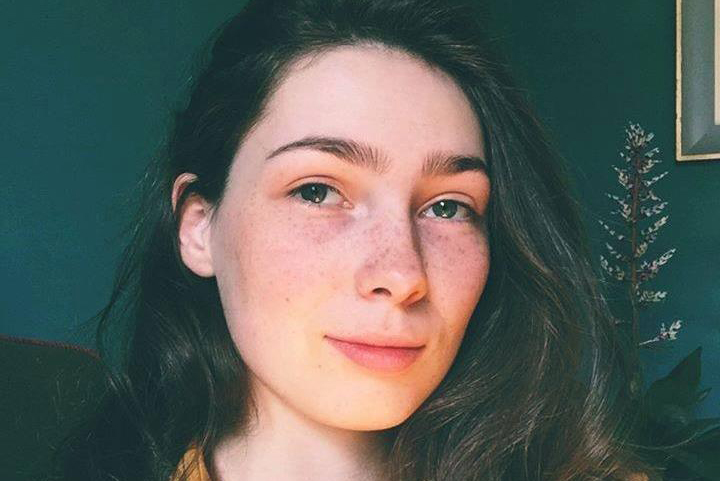Claire Oleson is a writer hailing from Grand Rapids Michigan. She's a 2019 grad of Kenyon College, where she studied English and Creative Writing. Her work has been published by the Kenyon Review online, the University of Kentucky's graduate literary journal Limestone, the LA Review of Books, and Newfound Press, among others. She is the 2019 winner of the Newfound Prose Prize. Her chapbook is forthcoming in May, 2020.
I think the weakest moments in writing come when a reader feels blind to the story, can't see it sentence-to-sentence, and feels little to no sensory understanding of what's taking place. In this sense I hope the pieces in this collection feel immersive, feel like they can fully arrive at the reader's eyes and nerves. —Claire Oleson
PATRYCJA HUMIENIK: Where did you grow up, and where are you based now?
CLAIRE OLESON: I'm from Grand Rapids Michigan, just graduated from Kenyon College in Ohio, and am currently living and working from home in Brooklyn for several literary agents in NY. I've got a fondness for the Midwest.
HUMIENIK: As a fellow Midwesterner (grew up in Evanston, just outside of Chicago), I’d love to hear more about this fondness!
OLESON: I think the Midwest is this deeply underrated place with long stretches of the valuable mundanity. The long car rides from my hometown to my college really got this across to me; you will talk to the other person in the car, if a person is there, because hour five of cornfields is going to get to you. You might also stop at Grandpa's Cheese Barn or a cherry-pit spitting pit (both are real). Michigan in particular has my bias and my heart. I spent a good chunk of my childhood in a house that is in the woods so I got to be near-feral in a lot of wonderful ways, got to catch a lot of snakes, got to get comfortable with animals and dirt, got to feel like a miniature Steve Irwin. The Midwest is arguably boring in some ways and devastatingly gorgeous in the right places and, I think, in getting so regularly overlooked, is a great place to look for and place story.
HUMIENIK: I agree, the Midwest does get overlooked. Do you have a first/early writing memory?
OLESON: I remember being bad at writing in second grade. Physically bad at writing with abhorrent penmanship that I still have some of today. I was also a slow typist but my second-grade teacher, who had her hand bitten by a dog and as a result could never quite unbend her pinky, insisted that if she could write and type with speed and precision, I could too. I'm pretty sure I still don't type as fast as Mrs. Dudley, who, in my memory, did impossible things on those clunky keyboards, but I appreciate the sentiment to this day.
HUMIENIK: Was there a catalyst (a character, image, moment) for your manuscript, “Things From The Creek Bed We Could Have Been”?
OLESON: There's no one, specific catalyst that started the manuscript. The pieces in “Things From The Creek Bed We Could Have Been” have all been written in the last four years with independent motivations. That being said, they share some themes and drives. Girlhood, water, and a possible sense of absurdism can be found in some form in each of these stories. Peaches can't float and three-headed greyhounds don't exist, but "Alluvium" and "Girls are for Emergencies" respectively operate outside of those realities. Some of these stories take ekphrastic inspiration, like "Son of My Uncle" and "Light Exposures" and "You were Snowing," which all deal with the space between the actual and the representative.
HUMIENIK: Who are some of the writers/artists that make up your writing lineage?
OLESON: They include but aren't limited to: Diane Seuss, Richard Siken, Danez Smith, Joyce Carol Oates, James Baldwin, Louise Erdrich, William Faulkner, Virginia Woolf, and Carl Phillips. Those are the ones that come to mind the quickest at the moment. As far as visual art goes, I really enjoy this contemporary painter, Lee Price, who does these hyper-realist paintings exploring the relationship between women and food.
HUMIENIK: You mention working outside of short-story conventions, and poets inform your writing lineage. Do you view genre as providing any meaningful constraints for your process as a writer, or do you push back against it? Would you characterize your work as hybrid?
OLESON: I usually like to avoid writing in a way that can be tagged as a distinct genre. I spent most of my undergraduate career darting between poetry and prose and I had a difficult time settling on either for my thesis project. I think they're both deeply wonderful. Poetry has certainly informed my work and has invited me to write at the site of the word rather than the sentence. I also feel I've gained a lot from seeing how poetry can use the image rather than narrative as its engine. While I certainly hope my short stories feel like they've got some good sentences and have narratives to share, I also know that they benefited from being composed with attention to the minute and with the intention for what a reader sees to matter as much (or more) than what they're told. Peaches, snow, bite-wounds, hallucinated tundras: these are just some of the pictures I used in these pieces to move my plots and I hope the readers can see them as sharply as the characters do.
HUMIENIK: Where are you drawing inspiration from these days? Can you speak to a piece of art you've encountered lately that has moved you?
OLESON: Over the past few years I've become really interested in trying to bring very visual elements into my written work. I think the weakest moments in writing come when a reader feels blind to the story, can't see it sentence-to-sentence, and feels little to no sensory understanding of what's taking place. In this sense I hope the pieces in this collection feel immersive, feel like they can fully arrive at the reader's eyes and nerves. I really enjoy delving into visual art and art history for inspiration because of this; my thesis piece for my undergrad career was an extended short story on sleeping disorders and a Pre-Raphaelite painting. As far as recent work, I'll say that I find Diane Seuss's “Still Life with Two Dead Peacocks and a Girl” and Kristen Arnett's “Mostly Dead Things” mesmerizing and inspiring, both incidentally sporting dead peacocks, and both with vested interest in creating worlds that the reader is invited to see down the stitches in a work of taxidermy.
HUMIENIK: What are you excited about in writing world right now?
OLESON: There's so much writing emerging now and so many authors and presses willing to branch out into the bizarre and canon-breaking territories, to take risks on the unconventional and challenge what we mean by writing and literature. I'm excited to see publishers like Newfound continue to work with authors like myself who are (I think) writing outside of short-story conventions and are eager to complicate genre and form.
 Patrycja Humienik is a trilingual Polish-American writer and performance artist. Her poetry is featured/forthcoming in Passages North, Yemassee, The Shallow Ends, Hobart, The Boiler, and No Tender Fences: An Online Anthology of Immigrant & First-Gen Poetry. She is the Events Director at The Seventh Wave and works in service of underrepresented grad students and faculty at the University of Washington.
Patrycja Humienik is a trilingual Polish-American writer and performance artist. Her poetry is featured/forthcoming in Passages North, Yemassee, The Shallow Ends, Hobart, The Boiler, and No Tender Fences: An Online Anthology of Immigrant & First-Gen Poetry. She is the Events Director at The Seventh Wave and works in service of underrepresented grad students and faculty at the University of Washington.

